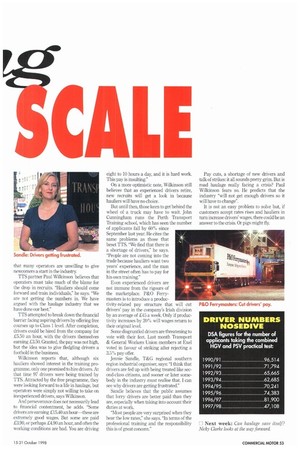When a driver training school goes to the wall, it's
Page 54

Page 55

If you've noticed an error in this article please click here to report it so we can fix it.
a sure sign that something's not right. As winter approaches road haulage is facing a crisis: strikes are looming while HGV licence applications are plummeting. In the first of a two-part series, Tim Maughan investigates an industry on the brink...
There's trouble afoot in the haulage industry, and it all comes down to one big subject: money. Not only is drivers' pay being frozen, but in many cases it is being cut. So it is hardly surprising that the number of applications for HGV driving courses has fallen dramatically—in some cases by as much as 60%.
Add to this a recent Government-commissioned report, which gives truck drivers the same social status as traffic wardens and assembly-line workers, and you have all the ingredients for a winter of discontent.
Haulage has been through plenty of tough periods before, so is this one really that bad?
Exel: Hit by pay dispute.
Well, in some cases it has already reached crisis point because, as well as a shortage of new drivers, the industry is suffering from a chronic lack of investment. Low pay may be cited as a factor, but some of the blame must be apportioned to the hauliers themselves.
It is not difficult to spot a major reason for the shortage of would-be HGV drivers: yet again the problem is money. The man in the street invariably has to pay for his own training—and it does not come cheap. A course and Class 1 test will cost about .0,000, with no guarantee of a job at the end of it.
One company, Lincoln-based Transport Training Services, set out to help the unqualified find driving jobs in the haulage business. But it has gone to the wall amid accusations that many operators are unwilling to give newcomers a start in the industry.
TTS partner Paul Wilkinson believes that operators must take much of the blame for the drop in recruits. "Hauliers should come forward and train individuals," he says. "We are not getting the numbers in. We have argued with the haulage industry that we have done our best."
ITS attempted to break down the financial barrier facing aspiring drivers by offering free courses up to Class 1 level. After completion, drivers could be hired from the company for £5.50 an hour, with the drivers themselves earning .,C3.50. Granted, the pay was not high, but the idea was to give fledgling drivers a foothold in the business.
Wilkinson reports that, although six hauliers showed interest in the training programme, only one promised to hire drivers. At that time 97 drivers were being trained by ns. Attracted by the free programme, they were looking forward to a life in haulage, but operators were simply not willing to take on inexperienced drivers, says Wilkinson.
And perseverance does not necessarily lead to financial contentment, he adds. "Some drivers are earning £15.40 an hour—these are extremely good wages. But some are paid £3.90, or perhaps £4.90 an hour, and often the working conditions are bad. You are driving eight to 10 hours a day, and it is hard work. This pay is insulting."
On a more optimistic note, Wilkinson still believes that as experienced drivers retire, new recruits will get a look in because hauliers will have no choice.
But until then, those keen to get behind the wheel of a truck may have to wait. John Cunningham runs the Perth Transport Training school, which has seen the number of applicants fall by 60% since September last year. He cites the same problems as those that beset TTS. "We find that there is a shortage of drivers," he says. "People are not coming into the trade because hauliers want two years' experience, and the man in the street often has to pay for his own training."
Even experienced drivers are not immune from the rigours of the marketplace. P&O Ferrymasters is to introduce a productivity-related pay structure that will cut drivers' pay in the company's Irish division by an average of £45 a week. Only if productivity increases by 20% will wages return to their original level.
Some disgruntled drivers are threatening to vote with their feet. Last month Transport & General Workers Union members at Exel voted in favour of striking after rejecting a 3.5% pay offer.
Jennie Sandie, T&G regional southern region industrial organiser, says: "I think that drivers are fed up with being treated like second-class citizens, and sooner or later somebody in the industry must realise that. I can see why drivers are getting frustrated."
Sandle believes that the public assumes that lorry drivers are better paid than they are, especially when taking into account their duties at work.
"Most people are very surprised when they hear the low rates," she says. "In terms of the professional training and the responsibility this is of great concern." Pay cuts, a shortage of new drivers and talk of strikes: it all sounds pretty grim. But is road haulage really facing a crisis? Paul Wilkinson fears so. He predicts that the industry "will not get enough drivers so it will have to change".
It is not an easy problem to solve but, if customers accept rates rises and hauliers in turn increase drivers' wages, there could be an answer to the crisis. Or pigs might fly.
DRIVER NUMBERS NOSEDIVE
DSA figures for the number of applicants taking the combined HGV and PSV practical test:
1990/91 96,514 1991/92 71,794 1992/93 65,665 1993/94 62,685 1994/95 70,241 1995/96 74,383 1996/97 81,900 1997/98 47,108




















































































































